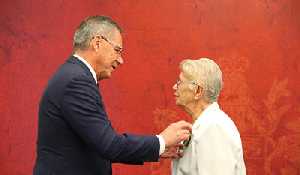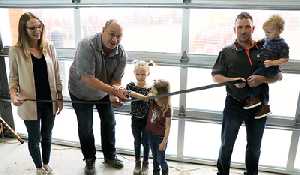Coroner’s inquest hears details of high-speed chase
“I definitely felt fear for my life” says officer
February 28, 2024, 4:39 pm
Ryan Kiedrowski, Local Journalism Initiative Reporter


The third day of a coroner’s inquest into the death of Myles Sanderson focussed on the high-speed chase and emergency response that occurred on Sept. 7, 2022. On that day, Sanderson was sighted in the One Arrow First Nation area after Saskatchewan’s largest killing spree on the James Smith Cree Nation and Village of Weldon.
Cst. Bill Rowley was working at the Rosthern Detachment on that fateful day when he heard the ‘be on the lookout’ (BOLO) call come over dispatch. During his testimony on Feb. 28 in Saskatoon, he described his actions and those observed by other members during the chase and vehicular takedown.
“It was a very dramatic unfolding situation. It was obviously very dangerous,” Cst. Rowley recalled. “Some extremely high speeds up to one point up to 167 km an hour.”
Coroner’s counsel Timothy Hawryluk asked Cst. Rowley if he’d ever experienced anything like this in his 23-year career with the RCMP.
“I have been in multiple pursuits before but nothing of this magnitude,” he replied. “It was very alarming and very concerning, I honestly thought that there was going to be collisions at that point.”
As the jury learned, there were points during the high-speed chased where Sanderson appeared to be aiming at oncoming vehicles while driving the wrong way down Highway 11.
“I do recall certain instances where there were some very, very close calls to the point where I thought there was going to be a head on collision,” said Cst. Rowley. “There were several vehicles that ended up having to take a ditch doing evasive action to avoid a head on collision.”
Meanwhile, Cst. Sean Nave set up a spike belt along the highway, preparing for Sanderson’s arrival.
“I definitely felt fear for my life,” he testified, adding that he was planning what his escape route might be should the truck come for him. “Very vulnerable is an understatement. I truly did feel I was in a very vulnerable position to be hit.”
As the jury heard yesterday, Cst. Heidi Marshall initiated a very high risk ‘pit maneuver’ to disable Sanderson’s vehicle. This consisted of Cst. Marshall contacting the rear passenger corner of the Sanderson’s truck, then delivering a nudge. This caused the truck to spin clockwise and into the ditch while Cst. Marshall’s police vehicle was able to emerge unscathed.
RCMP were then able to safely surround the Avalanche and prepare to interact with the driver.
Cst. Rowley along with Cst. Travis Adema were the officers who removed Sanderson from the truck, arresting him facedown before holding him to an RCMP vehicle in order to frisk the man.
“I had a lot of safety concerns for myself, my co-workers, the public and for Myles himself,” said Cst. Adema. “I truly felt that apprehending him as quickly as possible, as safely as possible was the only way to make this come to a conclusion.”
Cst. Rowley had opened the driver’s side door and recounted his thoughts in those frantic moments.
“I was under the expectation that he was coming out to finish someone finished business,” he said. “I didn't think it was going to go down the way it did. I expected him to come out with either a knife or a firearm, and I thought it was going to turn into a shootout.”
After managing to handcuff Sanderson, Cst. Rowley described the man’s demeanour as officers searched him.
“His attitude was very smug, cocky and arrogant,” Cst. Rowley explained. “He was laughing was directing comments to us that we should have shot him, asking how many bodies he got and was just very arrogant for somebody that had done something like that. It seemed like it was just a continuation of what happened probably from Day One.”
Cst. Rowley recalls Sanderson acting “totally normal” as police searched him, seemingly not under the influence of drugs or alcohol. Cst. Rowley was holding Sanderson up, walking him to the police vehicle when that demeanour quickly changed.
“As I was about to put him inside, his body felt like it actually stopped,” Cst. Rowley remembered, adding that from past experience with people not wanting to enter an RCMP vehicle, he assumed Sanderson was balking as well.
“Seconds later, his body became heavier, he kind of fell into my body, so I was supporting his bodyweight,” he said.
Within a couple minutes, Sanderson went from alert and communicative with RCMP to convulsing on the ground.
When paramedics arrived, Cst. Adema noticed a plastic bag in Sanderson’s hand.
“When I looked at it further, I was able to see a clear plastic corner bag,” he said. “There was a white powder in there that I had seen and a green piece of paper. In my policing experiences, I know that if that was illicit substance or a drug, it's not uncommon for people that use these substances to roll up something like a piece of paper to nasally ingest whatever substance that is so effectively like ingesting it through a straw.”
Cst. Adema then passed the bag - which the inquest determined to be a bag of cocaine with a rolled up $20 bill inside - to Cst. Marshall in order to secure the evidence.
Through previous testimony, the inquest learned Sanderson died from acute cocaine overdose with 6.5 mg per litre of the substance in his blood combined with previously noted atherosclerosis.
According to Nick Machan, Operations Superintendent with Ottawa Paramedics, previous knowledge of cocaine intoxication would not have changed their mode of treatment at all. He was part of the team that arrived moments after Sanderson began to experience seizures at the site of his arrest until an ambulance arrived.
Machan and Cst. Nave would go on to be part of the crew in that ambulance taking Sanderson to Royal University Hospital in Saskatoon, where Sanderson was declared deceased.
Throughout the inquest, video of the high speed chase, vehicular takedown and initial medical care of Sanderson was played. While difficult to observe, Chelsea Stonestand (who represented the family of Bonnie and Gregory Burns at the Melfort inquest) noted it was an important part of the healing process.
“I think seeing those videos and seeing the dynamics play out, I think that has definitely helped a lot of members healing,” she said.
With two more witnesses to testify tomorrow, it is anticipated jurors will begin deliberations on Feb. 29. They’re tasked by presiding coroner Robert Kennedy with confirming the facts surrounding Sanderson’s death and possible recommendations to various entities to prevent future deaths from occuring.



































